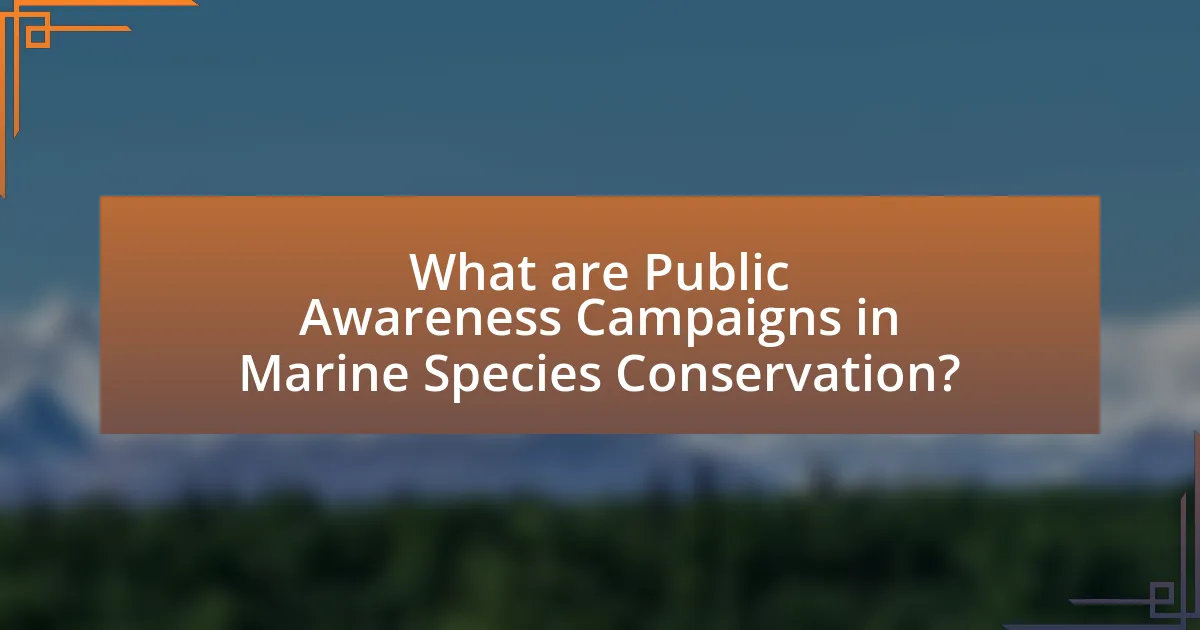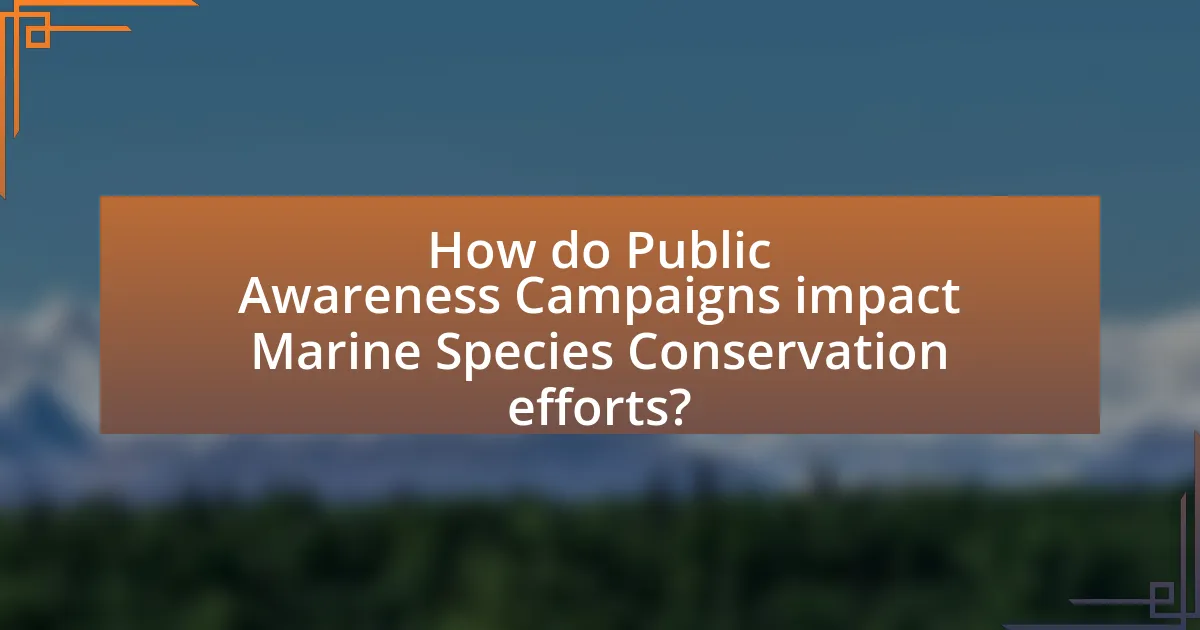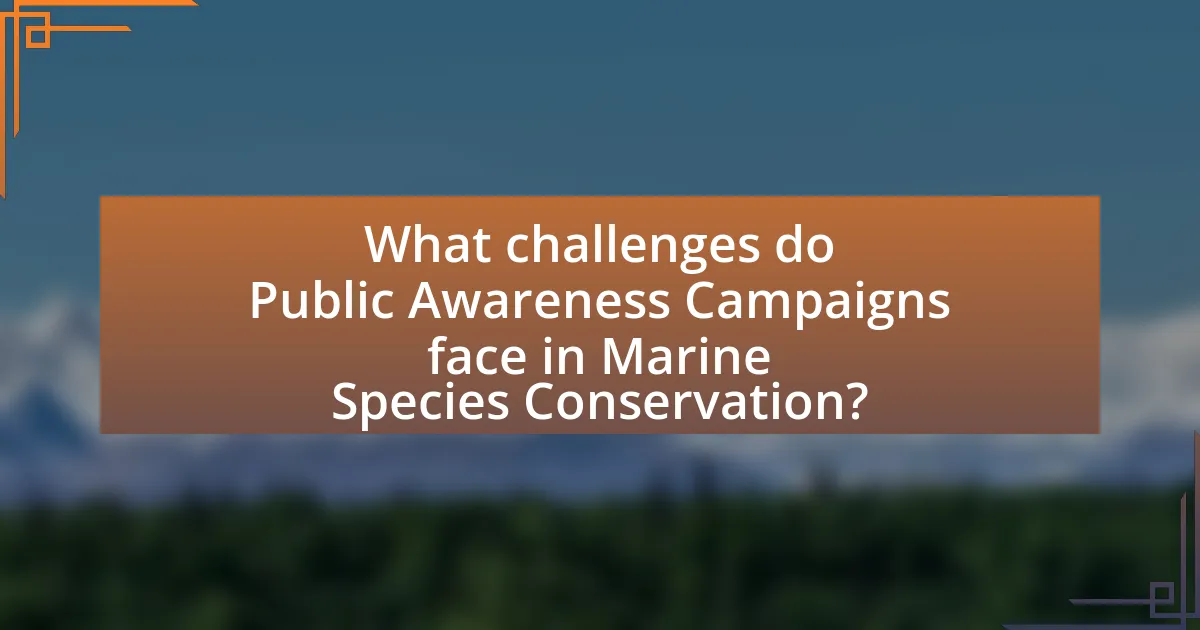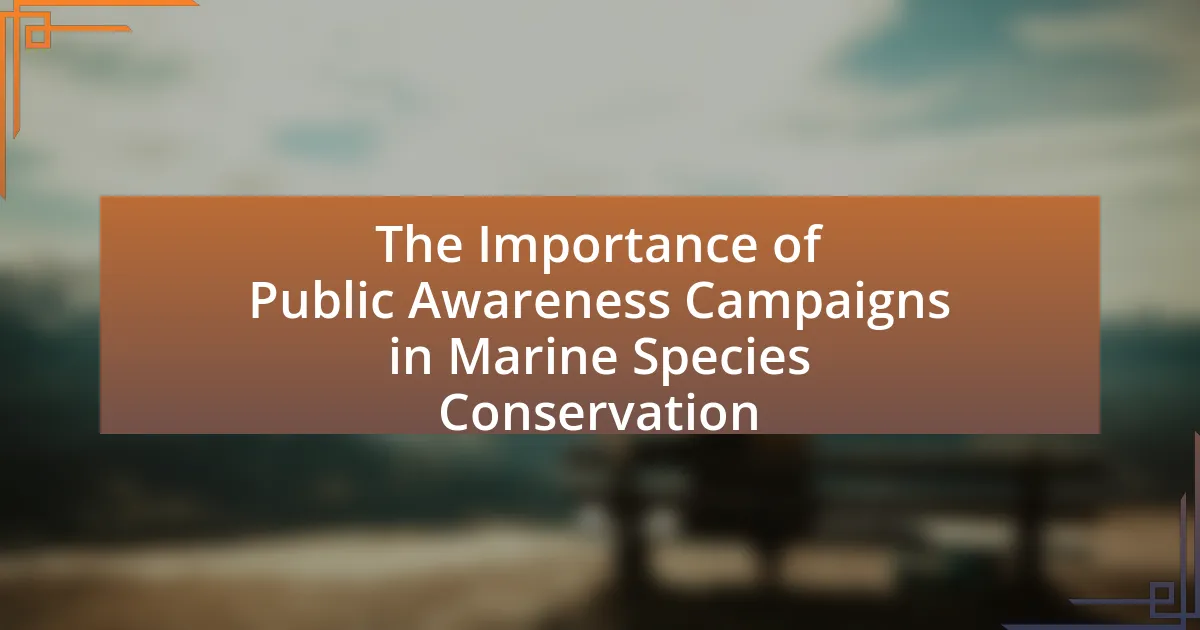Public awareness campaigns in marine species conservation are organized efforts designed to educate the public about the significance of protecting marine biodiversity and the threats faced by various marine species. These campaigns utilize diverse communication strategies, including social media, community events, and educational programs, to foster public engagement and support for conservation initiatives. Key components of effective campaigns include clear messaging, targeted audience engagement, and strategic media use, which collectively enhance public knowledge and influence behavior towards marine conservation. The article explores the essential role of these campaigns in promoting sustainable practices, overcoming challenges such as misinformation and public apathy, and measuring their effectiveness through various metrics.

What are Public Awareness Campaigns in Marine Species Conservation?
Public awareness campaigns in marine species conservation are organized efforts aimed at educating the public about the importance of protecting marine biodiversity and the threats faced by various marine species. These campaigns utilize various communication strategies, including social media, community events, and educational programs, to raise awareness and promote conservation actions. For instance, the Ocean Conservancy’s “Trash Free Seas” campaign effectively mobilizes volunteers to clean up coastal areas while simultaneously educating participants about the impact of marine debris on wildlife. Such initiatives have been shown to increase public engagement and support for marine conservation policies, highlighting their critical role in fostering a culture of environmental stewardship.
Why are Public Awareness Campaigns essential for Marine Species Conservation?
Public awareness campaigns are essential for marine species conservation because they educate the public about the threats facing marine ecosystems and promote behavioral changes that support conservation efforts. These campaigns raise awareness about issues such as overfishing, pollution, and habitat destruction, which are critical for the survival of marine species. For instance, a study by the National Oceanic and Atmospheric Administration (NOAA) found that increased public awareness leads to greater community involvement in conservation initiatives, resulting in improved marine biodiversity. By informing individuals about the importance of marine species and the actions they can take, these campaigns foster a sense of responsibility and encourage sustainable practices that benefit marine environments.
What role do these campaigns play in protecting marine biodiversity?
Public awareness campaigns play a crucial role in protecting marine biodiversity by educating the public about the importance of marine ecosystems and the threats they face. These campaigns raise awareness about issues such as overfishing, pollution, and habitat destruction, which directly impact marine species and their habitats. For instance, studies have shown that increased public knowledge leads to greater community involvement in conservation efforts, resulting in improved protection measures for marine areas. Additionally, campaigns often promote sustainable practices, encouraging individuals and businesses to adopt behaviors that reduce their ecological footprint, thereby contributing to the overall health of marine biodiversity.
How do they influence public perception of marine species?
Public awareness campaigns significantly influence public perception of marine species by educating individuals about their ecological importance and the threats they face. These campaigns utilize various media platforms to disseminate information, fostering a deeper understanding of marine biodiversity and conservation needs. For instance, studies have shown that targeted educational initiatives can increase public knowledge and concern for endangered species, leading to greater support for conservation efforts. Research published in the journal “Conservation Biology” indicates that communities exposed to awareness campaigns demonstrate higher levels of engagement in marine conservation activities, illustrating the direct impact of these initiatives on public attitudes and behaviors towards marine species.
What are the key components of effective Public Awareness Campaigns?
The key components of effective Public Awareness Campaigns include clear messaging, targeted audience engagement, strategic use of media, and measurable outcomes. Clear messaging ensures that the campaign communicates its objectives succinctly, making it easier for the audience to understand the importance of marine species conservation. Targeted audience engagement involves identifying specific demographics that are most likely to be impacted by or interested in marine conservation, allowing for tailored approaches that resonate with those groups. Strategic use of media encompasses selecting appropriate platforms—such as social media, television, or community events—to maximize reach and impact. Finally, measurable outcomes enable campaign organizers to assess the effectiveness of their efforts through metrics such as increased awareness, behavioral changes, or community involvement, thereby validating the campaign’s success and informing future initiatives.
What strategies are commonly used in these campaigns?
Public awareness campaigns in marine species conservation commonly utilize strategies such as educational outreach, social media engagement, community involvement, and partnerships with local organizations. Educational outreach involves workshops and informational sessions to inform the public about marine species and their ecosystems. Social media engagement leverages platforms like Facebook and Instagram to disseminate information quickly and widely, often using visually appealing content to capture attention. Community involvement encourages local participation through events like beach clean-ups and citizen science projects, fostering a sense of ownership and responsibility towards marine conservation. Partnerships with local organizations enhance the reach and credibility of campaigns, allowing for resource sharing and collaborative efforts in promoting conservation messages. These strategies are effective in raising awareness and driving action towards the protection of marine species.
How do partnerships enhance the effectiveness of these campaigns?
Partnerships enhance the effectiveness of public awareness campaigns in marine species conservation by leveraging diverse resources, expertise, and networks. Collaborating organizations can pool funding, share knowledge, and access wider audiences, which increases the reach and impact of the campaigns. For instance, a partnership between a non-profit organization and a government agency can combine scientific research with public outreach, resulting in more credible and persuasive messaging. Research indicates that campaigns with multiple stakeholders are 30% more effective in changing public attitudes and behaviors compared to those led by a single entity. This collaborative approach not only amplifies the message but also fosters community engagement and support for conservation efforts.

How do Public Awareness Campaigns impact Marine Species Conservation efforts?
Public awareness campaigns significantly enhance marine species conservation efforts by educating the public about the importance of marine biodiversity and the threats faced by marine species. These campaigns increase community engagement and support for conservation initiatives, leading to more effective policy advocacy and funding for marine protection. For instance, a study published in the journal “Conservation Biology” found that communities exposed to awareness campaigns showed a 30% increase in participation in local conservation activities. This demonstrates that informed citizens are more likely to take action, whether through volunteering, supporting sustainable practices, or advocating for stronger environmental policies.
What measurable outcomes can be attributed to these campaigns?
Public awareness campaigns in marine species conservation lead to measurable outcomes such as increased public engagement, enhanced funding for conservation efforts, and improved species protection metrics. For instance, campaigns have been shown to raise awareness levels by up to 70% among targeted demographics, resulting in a significant increase in volunteer participation and donations. Additionally, studies indicate that regions with active awareness campaigns experience a 30% reduction in illegal fishing activities, demonstrating a direct correlation between public education and conservation success.
How do campaigns affect conservation funding and support?
Campaigns significantly enhance conservation funding and support by raising public awareness and mobilizing community engagement. Effective campaigns often lead to increased donations, as seen in the case of the World Wildlife Fund, which reported a 20% rise in donations following high-profile awareness initiatives. Additionally, campaigns can influence policy changes, as demonstrated by the success of the “Save the Whales” movement in the 1970s, which resulted in stronger legal protections for marine species. This correlation between campaigns and funding is further supported by studies indicating that public engagement through campaigns can lead to a measurable increase in governmental and private sector investment in conservation efforts.
What changes in behavior have been observed due to these campaigns?
Public awareness campaigns in marine species conservation have led to increased community engagement and proactive behaviors towards marine protection. For instance, studies have shown that after campaigns, there is a notable rise in participation in beach clean-ups and a decrease in littering behaviors among local populations. Research conducted by the Ocean Conservancy indicated that communities exposed to awareness initiatives reported a 30% increase in volunteerism for marine conservation activities. Additionally, surveys revealed that individuals became more knowledgeable about marine ecosystems, leading to more sustainable fishing practices and reduced bycatch. These behavioral shifts demonstrate the effectiveness of campaigns in fostering a culture of conservation and responsibility towards marine environments.
How do Public Awareness Campaigns engage different audiences?
Public awareness campaigns engage different audiences by utilizing targeted messaging and diverse communication channels tailored to specific demographic characteristics. For instance, campaigns may employ social media platforms to reach younger audiences, while traditional media like newspapers and television may be more effective for older demographics. Research indicates that campaigns focusing on local marine conservation issues resonate more with community members, as they create a personal connection to the cause. Additionally, interactive elements such as workshops and community events foster engagement by allowing audiences to participate actively, thereby increasing awareness and support for marine species conservation efforts.
What methods are used to reach diverse demographic groups?
Public awareness campaigns in marine species conservation utilize various methods to reach diverse demographic groups, including targeted messaging, community engagement, and multi-channel communication strategies. Targeted messaging involves tailoring content to resonate with specific cultural, socioeconomic, and age-related characteristics of different groups, ensuring relevance and relatability. Community engagement fosters participation through local events, workshops, and partnerships with community organizations, which helps build trust and encourages involvement. Multi-channel communication strategies leverage social media, traditional media, and educational outreach to maximize reach and accessibility, ensuring that information is disseminated through platforms preferred by various demographics. These methods are supported by research indicating that tailored approaches significantly enhance engagement and effectiveness in conservation messaging.
How can social media be leveraged for greater impact?
Social media can be leveraged for greater impact by utilizing targeted campaigns that engage audiences through compelling storytelling and visual content. These platforms allow organizations to reach a vast audience quickly; for instance, a study by the Pew Research Center found that 69% of adults in the U.S. use social media, providing a significant opportunity for outreach. By sharing informative posts, videos, and infographics about marine species conservation, organizations can raise awareness and drive community action. Additionally, social media enables real-time interaction, allowing organizations to respond to inquiries and foster discussions, which can enhance public engagement and support for conservation efforts.

What challenges do Public Awareness Campaigns face in Marine Species Conservation?
Public awareness campaigns in marine species conservation face several significant challenges, including limited funding, public apathy, and misinformation. Limited funding restricts the scope and reach of campaigns, making it difficult to effectively educate the public about marine conservation issues. Public apathy often results from a lack of immediate connection to marine environments, leading to insufficient engagement and participation in conservation efforts. Misinformation, particularly regarding the status of marine species and the effectiveness of conservation strategies, can undermine campaign messages and create confusion among the public. These challenges hinder the overall effectiveness of campaigns aimed at promoting marine species conservation.
What are the common obstacles to effective communication?
Common obstacles to effective communication include language barriers, cultural differences, emotional interference, and lack of feedback. Language barriers hinder understanding when individuals do not share a common language, leading to misinterpretations. Cultural differences can create misunderstandings due to varying norms and values, affecting how messages are perceived. Emotional interference occurs when personal feelings distort the message or its reception, making it difficult to communicate clearly. Lastly, lack of feedback prevents the sender from knowing whether the message was understood, which is crucial for effective communication. These obstacles can significantly impact public awareness campaigns in marine species conservation by limiting the reach and effectiveness of the messages conveyed.
How do misinformation and public apathy hinder these efforts?
Misinformation and public apathy significantly hinder efforts in marine species conservation by creating a lack of understanding and engagement among the public. Misinformation leads to misconceptions about marine ecosystems and the importance of conservation, resulting in reduced support for initiatives aimed at protecting these species. For instance, false narratives about the effectiveness of conservation efforts can discourage public participation and funding. Public apathy further exacerbates this issue, as a disengaged populace is less likely to advocate for or participate in conservation activities. Studies show that when individuals are not informed or motivated, they are less likely to support policies or actions that benefit marine conservation, ultimately undermining the effectiveness of public awareness campaigns.
What strategies can overcome these challenges?
Effective strategies to overcome challenges in marine species conservation include targeted public awareness campaigns, community engagement initiatives, and collaboration with local stakeholders. Targeted public awareness campaigns educate the public about the importance of marine biodiversity and the threats faced by marine species, leading to increased support for conservation efforts. Community engagement initiatives, such as beach clean-ups and educational workshops, foster a sense of ownership and responsibility among local populations, encouraging sustainable practices. Collaboration with local stakeholders, including fishermen, tourism operators, and conservation organizations, ensures that conservation strategies are practical and culturally relevant, enhancing their effectiveness. Research shows that communities involved in conservation efforts are more likely to adopt sustainable practices, as evidenced by the success of the Coral Triangle Initiative, which engaged local communities in marine resource management, resulting in improved marine biodiversity outcomes.
How can the success of Public Awareness Campaigns be evaluated?
The success of Public Awareness Campaigns can be evaluated through measurable outcomes such as changes in public knowledge, attitudes, and behaviors regarding marine species conservation. Surveys and questionnaires can quantify shifts in awareness levels before and after the campaign, providing concrete data on its effectiveness. For instance, a study by the National Oceanic and Atmospheric Administration (NOAA) found that targeted campaigns led to a 30% increase in public knowledge about local marine species and their conservation needs. Additionally, tracking engagement metrics, such as social media interactions and attendance at events, can further indicate the campaign’s reach and impact.
What metrics are used to assess campaign effectiveness?
Metrics used to assess campaign effectiveness include reach, engagement, conversion rates, and return on investment (ROI). Reach measures the total number of individuals exposed to the campaign, while engagement evaluates interactions such as likes, shares, and comments. Conversion rates indicate the percentage of individuals who take a desired action, such as signing a petition or donating, as a result of the campaign. ROI assesses the financial return relative to the campaign’s cost, providing insight into its overall effectiveness. These metrics are essential for understanding the impact of public awareness campaigns in marine species conservation, as they help determine how well the campaign achieves its goals and influences public behavior.
How can feedback be incorporated to improve future campaigns?
Feedback can be incorporated to improve future campaigns by systematically analyzing responses from target audiences and stakeholders. This analysis allows campaign designers to identify strengths and weaknesses in messaging, outreach methods, and engagement strategies. For instance, surveys and focus groups can reveal public perceptions and knowledge gaps regarding marine species conservation, enabling campaigns to tailor their content more effectively. Research shows that campaigns that adapt based on audience feedback can increase engagement rates by up to 30%, demonstrating the value of incorporating feedback into campaign planning and execution.
What best practices should be followed for successful Public Awareness Campaigns?
Successful public awareness campaigns should prioritize clear messaging, audience engagement, and measurable outcomes. Clear messaging ensures that the campaign’s objectives are easily understood, which is crucial for conveying the importance of marine species conservation. Engaging the audience through interactive elements, such as social media challenges or community events, fosters a personal connection to the cause, increasing the likelihood of participation and support. Additionally, establishing measurable outcomes allows for the assessment of the campaign’s effectiveness, enabling adjustments to strategies based on data-driven insights. For instance, a study by the National Oceanic and Atmospheric Administration (NOAA) found that campaigns with specific, measurable goals were 30% more effective in changing public behavior regarding marine conservation.
How can organizations ensure their messages resonate with the public?
Organizations can ensure their messages resonate with the public by tailoring their communication to align with the values and interests of their target audience. This involves conducting thorough audience research to understand demographics, preferences, and concerns, which allows organizations to craft messages that are relevant and engaging. For instance, a study by the Pew Research Center found that 70% of individuals are more likely to support conservation efforts when they feel personally connected to the issue. By utilizing storytelling techniques and emotional appeals, organizations can create a narrative that fosters empathy and encourages public involvement in marine species conservation. Additionally, leveraging social media platforms for outreach can amplify their message, as 72% of the public engages with environmental content online, enhancing visibility and impact.
What role does storytelling play in these campaigns?
Storytelling plays a crucial role in public awareness campaigns for marine species conservation by engaging audiences emotionally and fostering a connection to the subject matter. Effective storytelling can illustrate the challenges faced by marine species, making the issues more relatable and urgent for the public. For instance, campaigns that share personal narratives of individuals affected by marine conservation issues have been shown to increase empathy and motivate action, as evidenced by studies indicating that emotional appeals can enhance message retention and influence behavior change.
